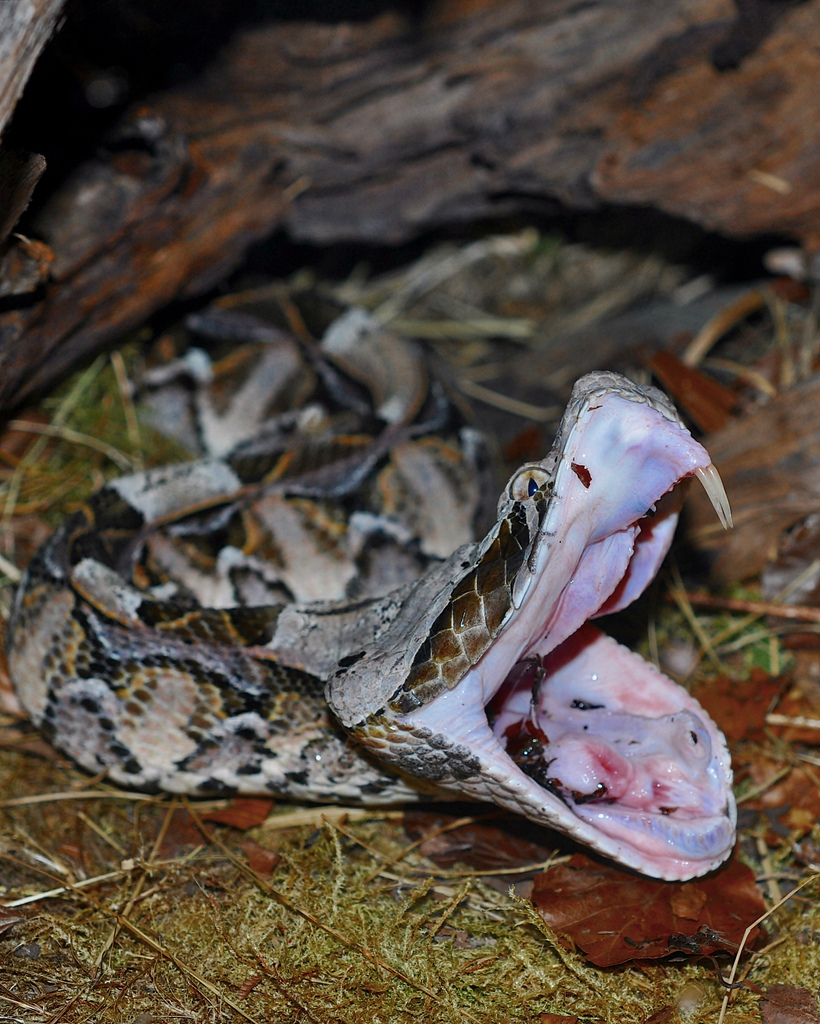The Gaboon viper striking is a captivating phenomenon that highlights the unique hunting techniques of this remarkable serpent. Found primarily in the rainforests and savannas of Central and West Africa, the Gaboon viper (Bitis gabonica) is known for its impressive size, striking patterns, and potent venom. This article delves deep into the world of the Gaboon viper, exploring its behavior, habitat, and the science behind its striking mechanism.
The Gaboon viper is not just another snake; it is a creature of extraordinary beauty and deadly efficiency. With a length that can exceed 2 meters and a distinctive triangular head adorned with intricate patterns, it is truly a sight to behold. The striking of the Gaboon viper is a critical aspect of its survival, allowing it to capture prey with remarkable speed and accuracy. In the following sections, we will examine the anatomy and techniques that enable the Gaboon viper to strike effectively.
Understanding the Gaboon viper and its striking capabilities is essential for both wildlife enthusiasts and those living in areas where these snakes are found. By appreciating the biology and behavior of this species, we can foster a greater respect for nature and the role these snakes play in their ecosystems. Join us as we unravel the mysteries of the Gaboon viper striking and learn more about this fascinating reptile.
Table of Contents
- Biology of the Gaboon Viper
- Habitat and Distribution
- The Striking Mechanism
- Understanding Gaboon Viper Venom
- Prey and Hunting Techniques
- Behavior and Temperament
- Conservation Status
- Common Myths about Gaboon Vipers
Biology of the Gaboon Viper
The Gaboon viper is one of the largest vipers in the world, characterized by its distinctive physical features. Here are some key biological aspects:
- Length: Typically between 1.5 to 2 meters, with some individuals exceeding 2.5 meters.
- Weight: Can weigh up to 10 kg.
- Coloration: A blend of brown, gray, and cream with intricate patterns that provide excellent camouflage.
- Head: Triangular and flat, with prominent brow ridges and large fangs.
Personal Data and Biodata
| Attribute | Details |
|---|---|
| Scientific Name | Bitis gabonica |
| Family | Viperidae |
| Habitat | Rainforests and Savannas of Central and West Africa |
| Conservation Status | Least Concern (IUCN) |
Habitat and Distribution
The Gaboon viper is primarily found in the dense rainforests and savannas of Central and West Africa. Its habitat preferences include:
- Moist, humid environments with plenty of vegetation.
- Areas near rivers and streams, which provide ample drinking water.
- Soil types that allow for easy burrowing and hiding from predators.
The Striking Mechanism
The Gaboon viper's striking mechanism is a marvel of evolution. Here are the key components of how it strikes:
- Muscle Structure: The viper has powerful muscles that enable it to launch a strike in less than a second.
- Fang Design: Its long, hollow fangs allow for deep penetration and efficient delivery of venom.
- Camouflage: The Gaboon viper's coloration provides excellent camouflage, allowing it to ambush prey effectively.
Understanding Gaboon Viper Venom
The venom of the Gaboon viper is one of the most potent among snakes. Here’s what you need to know:
- Composition: The venom contains proteolytic enzymes that can break down proteins in prey.
- Effects: Envenomation can cause severe tissue damage and systemic effects in prey.
- Medical Importance: While dangerous, Gaboon viper venom is studied for potential medical applications, including pain management.
Prey and Hunting Techniques
The Gaboon viper primarily preys on small mammals, birds, and reptiles. Its hunting techniques include:
- Ambush: The viper often lies in wait for unsuspecting prey to come close.
- Striking: It strikes with incredible speed, often injecting venom before the prey can react.
- Swallowing: After immobilizing its prey, the Gaboon viper swallows it whole.
Behavior and Temperament
Despite its fearsome reputation, the Gaboon viper generally exhibits calm behavior. Key behavioral traits include:
- Defensive Nature: When threatened, it may hiss or puff up but rarely attacks unless provoked.
- Solitary: Gaboon vipers are primarily solitary creatures, coming together only for mating purposes.
Conservation Status
The Gaboon viper is currently listed as "Least Concern" by the IUCN, but habitat loss and poaching pose threats to its population. Conservation efforts include:
- Habitat Protection: Preserving rainforests and savanna ecosystems to maintain their natural habitat.
- Education: Raising awareness about the importance of vipers in their ecosystems.
Common Myths about Gaboon Vipers
There are many myths surrounding the Gaboon viper. Some of the most common include:
- Myth 1: All vipers are aggressive and will attack without provocation.
- Myth 2: Gaboon vipers can strike from any position.
- Myth 3: Their venom is always lethal to humans.
Conclusion
In conclusion, the Gaboon viper striking is a fascinating subject that highlights the incredible adaptations of this remarkable snake. From its powerful strike to its potent venom, the Gaboon viper is a true marvel of nature. We encourage you to share your thoughts and experiences with Gaboon vipers in the comments below, and feel free to explore more articles on our site to deepen your understanding of wildlife.
Penutup
Thank you for exploring the intriguing world of the Gaboon viper with us. We hope this article has provided valuable insights and fostered a greater appreciation for this beautiful yet dangerous creature. Don't forget to visit us again for more articles on the wonders of nature!
George Conway Nationality: A Deep Dive Into His Background And Heritage
Officer Chen: The Rise Of A Talented Actress
6th May Birthday Personality: Exploring The Traits And Characteristics


